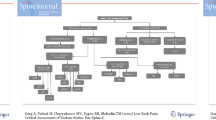Abstract
The aims were to investigate how the body image is affected in fibromyalgia syndrome (FMS) in comparison to healthy people, as well as to explore the relationship of the body image with the level of pain, functional status, severity of depression, and quality of life (QoL). Demographic variables, symptoms of fibromyalgia, and number of fibromyalgia tender points for 51 patients with FMS and 41 control subjects were recorded. All patients were asked to mark the level of pain on visual analogue scale (VAS). Six-minute walking test was recorded for functional assessment. The impact of the disease was evaluated by fibromyalgia impact questionnaire (FIQ). All patients were asked to complete body image scale (BIS), Beck depression inventory (BDI), and short form-36 (SF-36). There were no differences between groups with regard to demographic variables (p > 0.05). Mean VAS was 7.5 ± 1.4 for the patients with FMS and 0.3 ± 0.4 for control subjects (p < 0.05). Mean FIQ was 70.8 ± 13.2 and 8.2 ± 9.6 for the FMS and control groups, respectively (p < 0.05). Mean BIS and BDI were 106.5 ± 24.0 and 20.2 ± 11.2 for FMS group and 66.3 ± 23.4 and 3.4 ± 4.0 for control group, respectively (p < 0.05). SF-36 subscores were found to be significantly lower in patients with FMS than control subjects (p < 0.05), except for the social function subscore. BIS score had significant relationships both with VAS (r = 0.843) and FIQ (r = 0.290) in patients with FMS (p < 0.05). There were significant relationships between BIS scores and SF-36 pain (r = −0.288), energy/vitality (r = −0.519), mental health (r = −0.442), and general health (r = −0,492) subscores (p < 0.05). Body image was associated with VAS in the multivariate linear regression analysis. The results of the present study indicate that body image is disturbed in patients with FMS compared to control subjects. For the evaluation of the level of pain, impact of the disease, and QoL in patients with FMS, it would be useful to consider the relationship of the body image disturbance with these parameters.
Similar content being viewed by others
References
Boyington JE, DeVellis R, Shreffler J, Schoster B, Callahan LF (2008) Factor structure of the arthritis body experience scale (ABES) in a U.S. population of people with osteoarthritis (OA), rheumatoid Arthritis (RA), fibromyalgia (FM) and other rheumatic conditions. Open Rheumatol J 2:64–70
Lotze M, Moseley GL (2007) Role of distorted body image in pain. Curr Rheumatol Rep 9(6):488–96
Yunus MB, Masi AT, Aldag JC (1989) A controlled study of primary fibromyalgia syndrome: clinical features and association with other functional syndromes. J Rheumatol 19:62–71
Moseley GL (2005) Distorted body image in complex regional pain syndrome type 1. Neurology 65:773
Monaghan SM, Sharpe L, Denton F, Levy J, Schrieber L, Sensky T (2007) Relationship between appearance and psychological distress in rheumatic diseases. Arthritis Rheum 57(2):303–309
Mannerkorpi K, Nordeman L, Cider A, Jonsson G (2010) Does moderate-to-high intensity Nordic walking improve functional capacity and pain in fibromyalgia? a prospective randomized controlled trial. Arthritis Res Ther 12(5):R189
Bennett R (2005) The fibromyalgia impact questionnaire (FIQ): a review of its development, current version, operating characteristics and uses. Clin Exp Rheumatol 23:154–162
Jourard A, Secord P (1955) Body cathexis and the ideal female figure. J Abnorm Soc Psychol 50:243–246
Beck AT, Ward CH, Mendelson M, Mock J, Erbaugh J (1961) An inventory for measuring depression. Arch Gen Psychiatry 4:53–63
Beck AT, Steer RA, Garbin MG (1988) Psychometric properties of the Beck depression inventory: twenty-five years of evaluation. Clin Psychol Rev 8:77–100
Ware JE Jr (1992) Sherbourne CD. The MOS 36-item short-form health survey (SF-36). I. Conceptual framework and item selection. Med Care 30:473–83
Vamos M, White GL, Caughey DE (1990) Body image in rheumatoid arthritis: the relevance of hand appearance to desire for surgery. Br J Med Psychol 63:267–277
Shapiro JR, Anderson DA, Danoff-Burg S (2005) A pilot study of the effects of behavioral weight loss treatment on fibromyalgia symptoms. J Psychosom Res 59(5):275–82
Flor H, Braun C, Elbert T, Birbaumer N (1997) Extensive reorganization of primary somatosensory cortex in chronic back pain patients. Neurosci Lett 224:5–8
Kaas JH, Florence SL (1997) Mechanisms of reorganization in sensory systems of primates after peripheral nerve injury. Adv Neurol 73:147–158
Pelled G, Chuang KH, Dodd SJ, Koretsky AP (2007) Functional MRI detection of bilateral cortical reorganization in the rodent brain following peripheral nerve deafferentation. NeuroImage 37:262–273
Ben-Tovim DI, Walker MK (1995) Body image disfigurement and disability. J Psychosom Res 39:283–291
Skevington SM, Blackwell F, Britton NF (1987) Self-esteem and perception of attractiveness: an investigation of early rheumatoid arthritis. Br J Med Psychol 60:45–52
Novy DM, Nelson DV, Averill PM, Berry LA (1996) Gender differences in the expression of depressive symptoms among chronic pain patients. Clin J Pain 12(1):23–29
Gavin AR, Simon GE, Ludman EJ (2010) The association between obesity, depression, and educational attaintment in women: the mediating role of body image dissatisfaction. J Psychosom Res 69:573–581
Rossy LA, Buckelew SP, Dorr N, Hagglund KJ, Thayer JF, McIntosh MJ, Hewett JE, Johnson JC (1999) A meta-analysis of fibromiyalgia treatment interventions. Ann Behav Med 21:180–191
Disclosures
None.
Author information
Authors and Affiliations
Corresponding author
Rights and permissions
About this article
Cite this article
Akkaya, N., Akkaya, S., Atalay, N.S. et al. Relationship between the body image and level of pain, functional status, severity of depression, and quality of life in patients with fibromyalgia syndrome. Clin Rheumatol 31, 983–988 (2012). https://doi.org/10.1007/s10067-012-1965-9
Received:
Revised:
Accepted:
Published:
Issue Date:
DOI: https://doi.org/10.1007/s10067-012-1965-9




